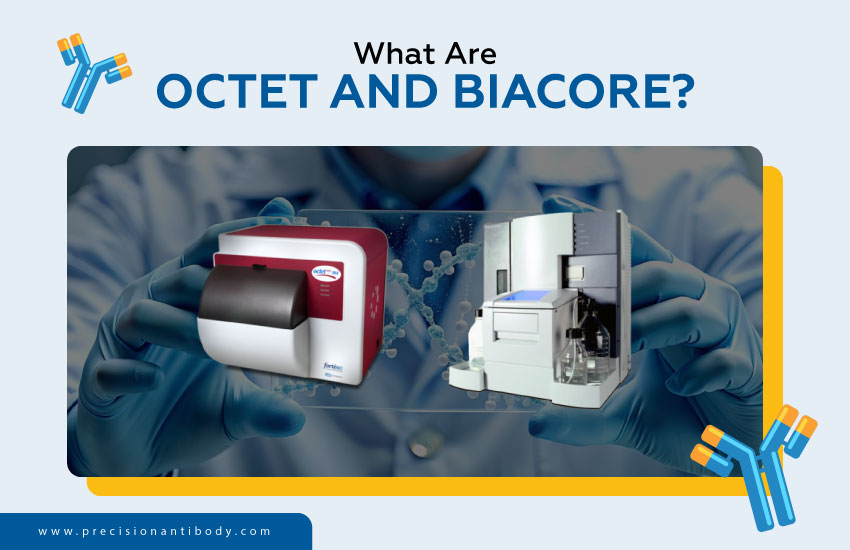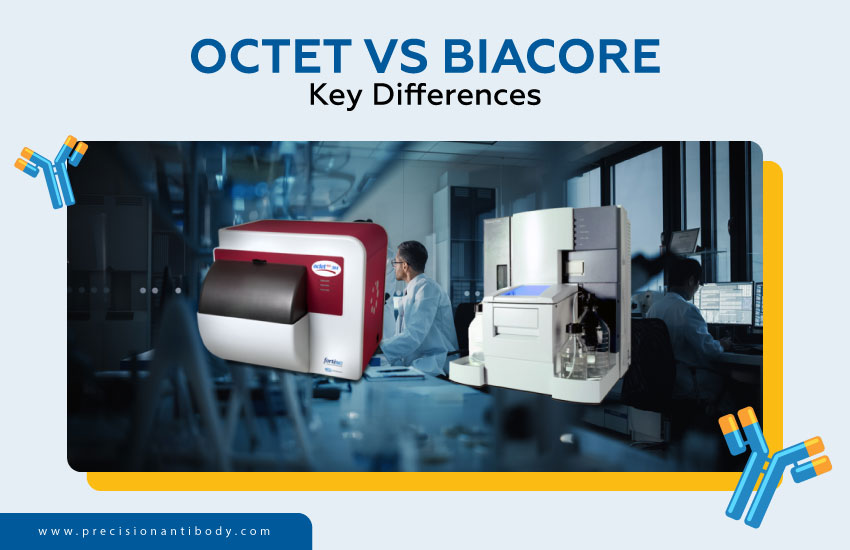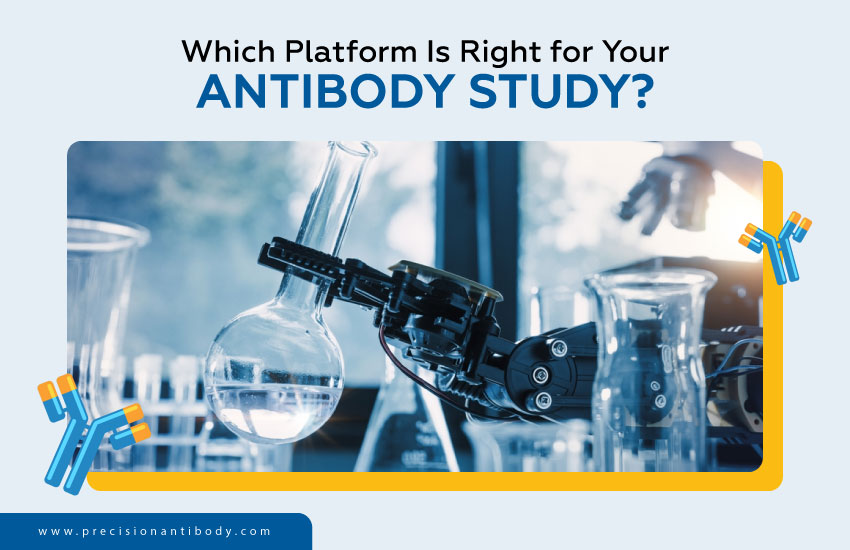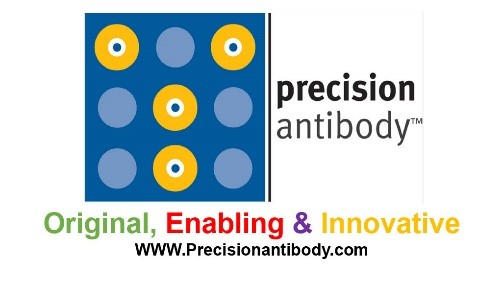
Researchers extensively use analysis platforms such as Octet and Biacore to investigate biomolecular interactions in real time without labeling. Understanding how molecules bind, how tightly they stick to each other, and how selectively they interact is very important in fields like drug development and biochemistry. These systems are key to this understanding.
The Biacore system uses Surface Plasmon Resonance (SPR) technology to hold biomolecules on a sensor chip. When potential partners come into contact with the surface the system notices changes in the refractive index close to the sensor. This shows that binding events are happening. This method accurately measures how quickly molecules connect and disconnect, providing clear information about their interactions.
The Octet platform uses Bio-Layer Interferometry (BLI) to hold a ligand on a sensor tip. When this tip is dipped into a solution containing an analyte binding events change the optical thickness at the tip, changing the reflected light interference pattern. Researchers monitor this shift in real-time, allowing them to analyze binding kinetics and affinities without needing labels.
Each platform offers unique advantages. Biacore’s SPR delivers exceptional sensitivity and has remained essential in pharmaceutical research for decades. Octet’s BLI with its dip-and-read format, provides higher throughput, making it ideal for efficiently screening large numbers of interactions.
You can choose between these systems based on their sensitivity, sample size, and type of interaction experiment. The full article explores the advantages and considerations of each platform for antibody research.

Octet and Biacore are two prominent biosensor platforms that analyze biomolecular interactions in real-time without requiring labeling. Each system presents unique advantages and limitations making it suitable for various research applications.
| Feature | Biacore | Octet |
| Detection Technology | Surface Plasmon Resonance (SPR) | Bio-Layer Interferometry (BLI) |
| Throughput | Lower; typically handles fewer samples. Can analyze up to 4 samples at a time (including reference) | Higher; analyzes up to 8 samples simultaneously per run and up to 56 samples per plate |
| Sample Compatibility | Less tolerant of high solvent concentrations | More tolerant; can work with crude, unpurified samples |
| Sensitivity | High; suitable for small molecules | Moderate; may have limitations with small molecules |
| Data Quality | Excellent; high precision | Excellent; high precision |
| Cost | Higher; may limit accessibility | More cost-effective; accessible to a broader range of applications |
| Any Limitation | Can differentiate clones with pM affinities. Analyte molecular weight can be as low as 300Da | Can not differentiate clones with pM affinities. Analyte molecular weight has to be >3kDa |
When choosing a biosensor platform, researchers should consider their unique needs including sample type, throughput needs, sensitivity, and budget constraints. In conclusion, the choice between Biacore and Octet depends on specific experimental needs. Biacore is better for precise measurements and detecting small molecules, while Octet is excellent for testing many samples quickly and saving money.

Biacore and Octet systems have unique benefits. Therefore, it’s essential to consider your research’s particular needs when choosing the best platform for your antibody study. The choice should align with your research goals, striking a balance between the demands of data precision and throughput.
The sample type, needed sensitivity, budget, and experiment objectives are some variables that affect the decision between Octet and Biacore. Below, we discuss their capabilities in further depth.
Bio-Layer Interferometry (BLI) optically measures biomolecular interactions in real-time without labels. The Octet platform lets BLI monitor binding events by viewing white light patterns bouncing off a biosensor surface. This approach requires no fluorescent or radioactive markers. This shows binding affinities, kinetic variables, and association and dissociation rates.
BLI is a prominent tool for vaccine research and development. The technology examines the interactions between antigens and antibodies to understand immune responses better and evaluate vaccinations effectiveness. For instance BLI has been used to investigate the degree to which antibodies bind to specific viral proteins, providing crucial data for vaccine development.
BLI monitors protein-protein interactions in real time without labels. This expertise helps us understand biological processes by clarifying complex formation and dissociation dynamics. BLI has been used to study mitochondrial DNA polymerase component interactions to understand DNA copying better.
The investigation of ribosome protein interactions is another area in which BLI’s versatility is evident. Recent studies have found that BLI can effectively find interactions between ribosomes and translation factors.
It doesn’t require labeling, tests are conducted swiftly, and ribosomal samples can be reused. This application demonstrates BLI’s potential in researching the kinetics of protein synthesis.
Bio-Layer Interferometry helps study various biomolecular interactions when used in systems like Octet. It has helped improve molecular biology, biochemistry, and vaccine development.
An optical method called Surface Plasmon Resonance (SPR) allows for the real-time analysis of biomolecular interactions without labels. Devices like the Biacore system use SPR to monitor how molecules stick together. It provides valuable information about how strongly they bind and how quickly they attach and detach from each other.
Using this technique, one interaction partner is immobilized on a thin gold-coated sensor chip, and the second partner flows across the surface. The binding interactions induce changes in the refractive index near the sensor surface, which the sensorgrams detect and record.
Recent investigations have demonstrated the adaptability of SPR in various scientific applications. SPR has been used to measure how proteins and nucleic acids interact. This helps in finding and testing new treatments for diseases like HIV and lupus.
High-throughput Biacore SPR makes examining vast antibody libraries easy and finding correct-binding candidates quickly. This method accelerates therapeutic antibody development. Biacore SPR examines antibody candidates’ stability, affinity, and specificity.
Humanized monoclonal antibodies are checked with Biacore SPR to ensure they keep their valuable properties during production and storage. This application is essential for quality control in the biopharmaceutical sector, where preserving the uniformity and effectiveness of therapeutic antibodies is crucial.
Surface Plasmon Resonance (SPR) helps study different biomolecular interactions when used on platforms like Biacore. Due to its real-time, label-free detection capabilities, it benefits it in domains including drug development, molecular biology, and biochemistry.
Octet and Biacore are two prominent platforms used to analyze biomolecular interactions, each employing distinct technologies Bio Layer Interferometry (BLI) and Surface Plasmon Resonance (SPR), respectively.
The Octet system uses BLI, an optical method that detects the interference pattern of white light reflected from two surfaces: an internal reference layer and a layer containing immobilized protein. The biosensor tip’s optical thickness increases when a ligand is placed there and interacts with an analyte in the solution.
This alteration causes a shift in the interference pattern, which is closely correlated with the biological layer’s change in optical thickness and is quantified in nanometers. Real-time information on concentration, association and dissociation rates, and binding specificity can be obtained by tracking this change over time.
Biacore uses SPR, which measures variations in the refractive index near a sensor surface. On a sensor chip covered in a thin coating of metal, usually gold, one interaction partner (ligand) is immobilized.
The mass on the sensor surface changes due to binding events as the analyte passes over the chip, changing the refractive index. By altering the angle at which incident light causes surface plasmons or coherent electron oscillations, binding events can be detected and measured in real-time without labels.
When evaluating platforms for antibody studies, sensitivity, and data accuracy are critical factors to consider. The Octet and Biacore systems offer unique advantages and limitations in these areas.
Biacore’s SPR systems are usually best for studying antibodies because they offer high sensitivity and accurate data especially when dealing with small compounds or low amounts of substances.
On the other hand Octet’s BLI-based devices are a good alternative for situations where high speed is essential and more considerable molecules are involved. Still, they may sacrifice some accuracy and sensitivity in the data.
When selecting a platform for antibody studies throughput and sample efficiency are crucial considerations. The Octet and Biacore systems offer distinct advantages and limitations in these areas.
The Octet platform can quickly analyze many samples, making it perfect for long cross-competition tests and epitope binning tests. These tests need to check multiple antibody interactions effectively.
Octet allows for direct analysis of raw samples, saving preparation time and reducing the use of expensive materials. It is beneficial when working with restricted sample availability because of its fluid-free process, which lowers sample consumption.
Traditional Biacore technology processes fewer samples concurrently, potentially limiting the throughput of extensive analyses. However, because of developments in SPR technology, high-throughput devices that can analyze substantial antibody panels including epitope binning with less sample consumption have been developed.
To avoid clogging and guarantee data quality, traditional SPR systems need purified samples, which increases sample consumption and preparation time. However, contemporary high-throughput SPR platforms have been designed to minimize these needs.
Octet’s high-throughput analysis aids large-scale epitope binning and cross-competition investigations. The fluidics-free approach saves time and reagents by directly analyzing crude samples, especially when samples are scarce. Modern high-throughput SPR devices improve on older Biacore SPR systems by allowing large scale antibody research with small samples.
Both the Octet and Biacore platforms have clear benefits and drawbacks regarding accessibility and expense for antibody research.
Bio-Layer Interferometry (BLI) is a powerful method that allows us to measure biomolecular interactions in real time without using any labels. It is beneficial in various antibody research because of its unique “dip and read” configuration, which enables high-throughput screening without the complications of microfluidics.
For antibody research requiring high-throughput capabilities, real-time kinetic analysis, label-free detection, and adaptability to various applications, BLI is an excellent option. It is a favored platform in many research and development contexts due to its capacity to offer comprehensive insights into biomolecular interactions while preserving samples.
The advanced, label-free optical technology known as Surface Plasmon Resonance (SPR) makes real-time monitoring of biomolecular interactions possible. It is a valuable instrument in many antibody research applications because of its accuracy and adaptability.
For antibody studies that require detection without labels, use tiny amounts of samples, detailed analysis over time, and the ability to handle complex or rough samples, SPR is a great choice. It’s a popular tool for researchers who want to fully understand how antibodies and antigens interact because it is very sensitive and accurate.

Bio-Layer Interferometry (BLI) and Surface Plasmon Resonance (SPR) examine molecular interactions without labels. Each study approach has benefits. Octet-type BLIs enable high-throughput SPR. This “dip and read” method allows quick analysis without microfluidics, making it excellent for early antibody discovery and development. BLI has kinetics similar to SPR biosensors under ideal conditions.
Biacore and other SPR technologies are known for their sensitivity and precision in thorough kinetic profiling. For applications needing in-depth research, they provide excellent binding interaction data. BLI works faster, but SPR systems like Biacore offer better quality and consistent data. This makes SPR important for studying strong antibody-antigen interactions.
Your study needs should determine whether to use BLI or SPR. BLI is a promising solution for high-throughput screening and fast, flexible applications. SPR is the preferred method for comprehensive kinetic analysis and enhanced sensitivity.
By weighing the pros and downsides of each platform, researchers can choose the best one for antibody investigations. Stay tuned for our upcoming blog to examine the most recent developments in biosensor and antibody research. Do you have any questions or thoughts? We’d love to hear your thoughts, so please share in the comments!
If you want to read more about antibodies and antibody studies, check out our blog section!

Led by innovative minds in immunology and the antibody development field, Precision Antibody has been an industry leader for over 20 years. We not only implement a cutting-edge technique in antigen design, antibody development, production, and other analyses, but we are also constantly working on ways to improve and advance technology to match the ever-changing world of science. If you are interested in learning more about Precision Antibody’s Custom Antibody development.
Precision Antibody™ is the forefront of the global Custom Antibody industry & it is led by the innovative minds in immunology and antibody development field.